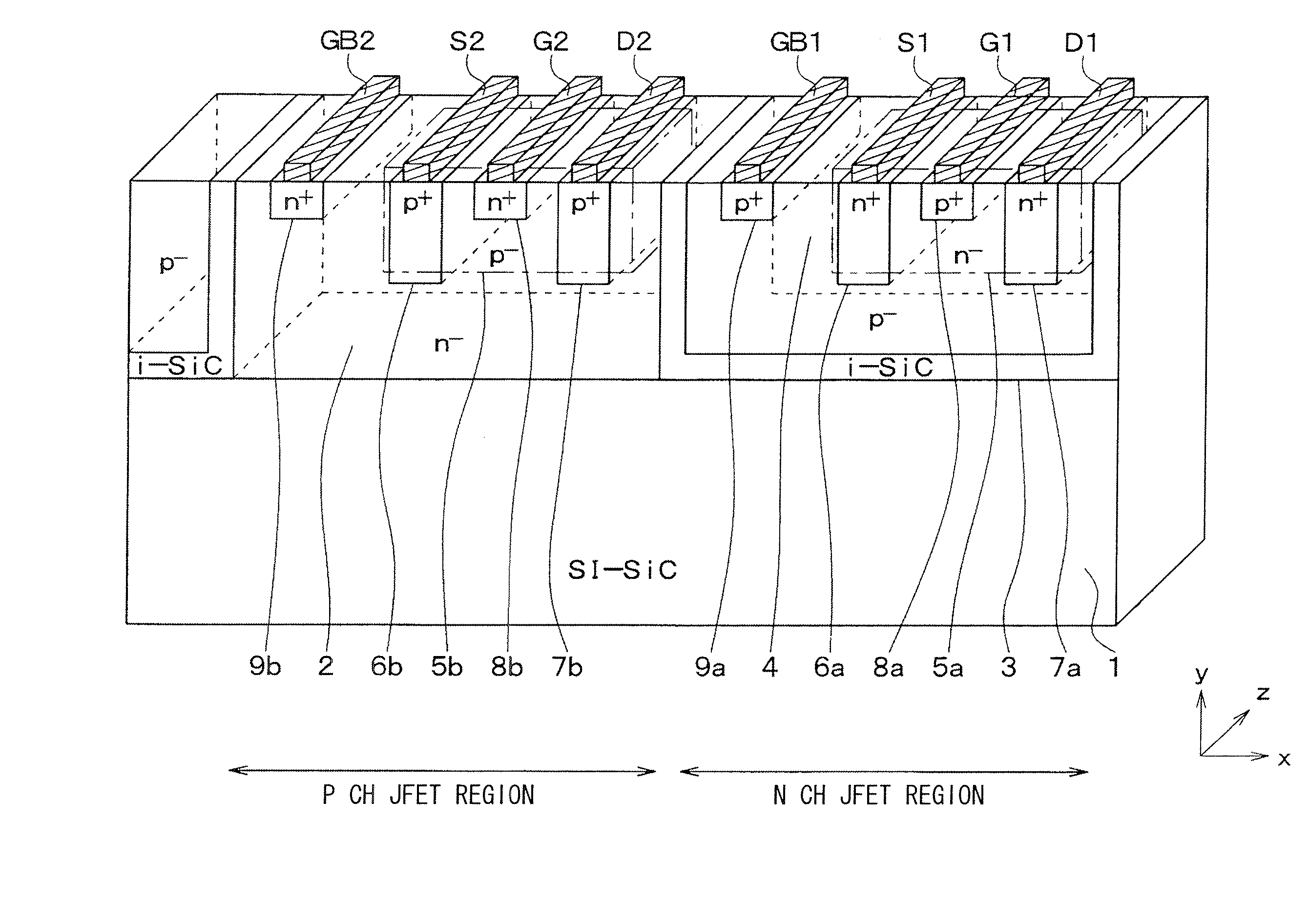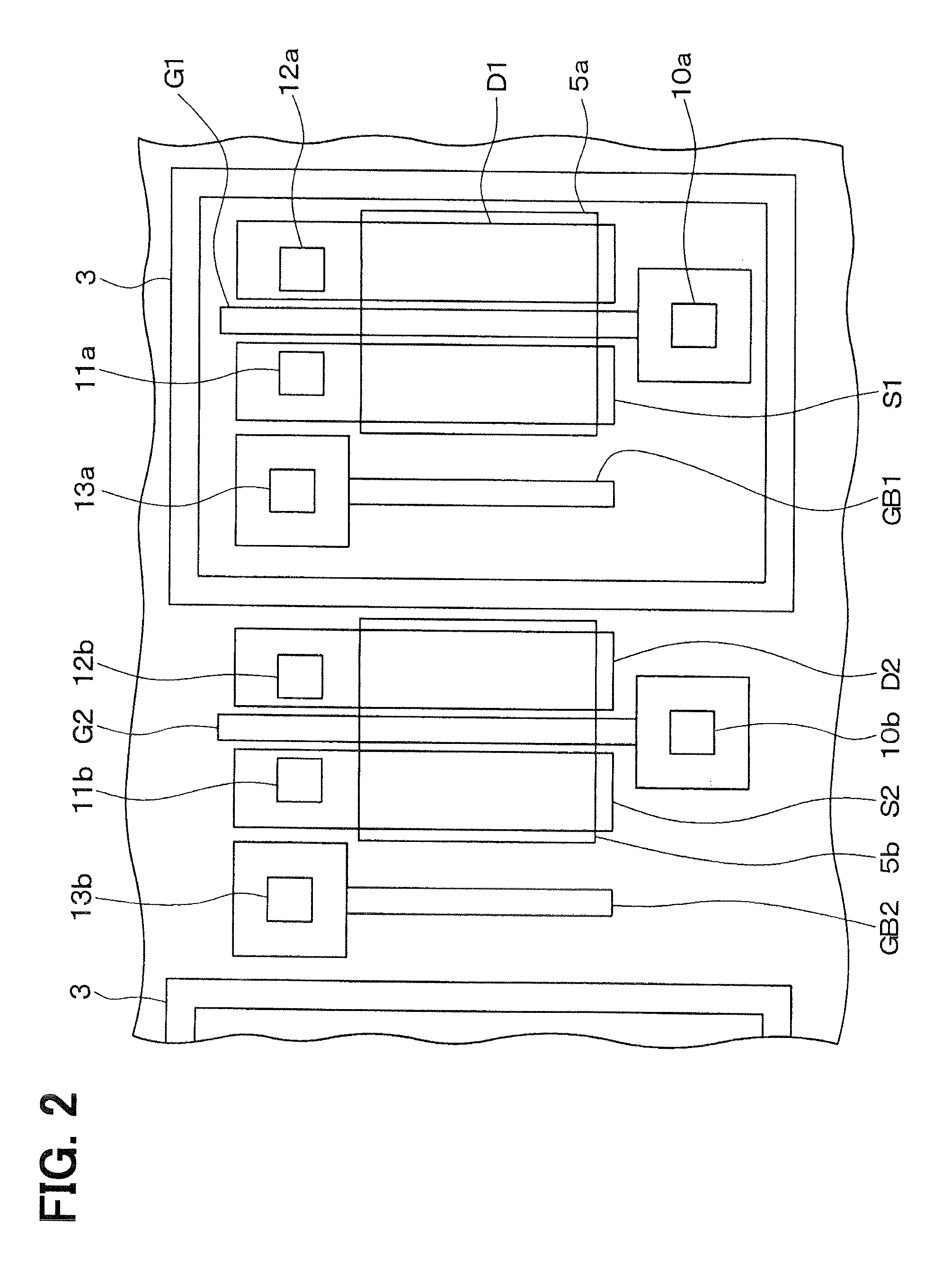Sic semiconductor device having cjfet and method for manufacturing the same
a semiconductor device and semiconductor technology, applied in the field of semiconductor devices, can solve the problems of restricted noise propagation at high frequency, high frequency noise is absorbed, and restricted and achieve the effect of reducing current leakage at high temperature and transmission at high frequency
- Summary
- Abstract
- Description
- Claims
- Application Information
AI Technical Summary
Benefits of technology
Problems solved by technology
Method used
Image
Examples
first embodiment
[0027]A SiC semiconductor device according to a first embodiment will be explained. FIG. 1 shows the SiC semiconductor device having a CJFET. FIG. 2 is a layout view of the SiC semiconductor device. A structure of the CJFET in the device will be explained as follows. In FIG. 1, a right-left direction of the drawing is defined as X direction, an up-down direction of the drawing is defined as a Y direction, and a direction perpendicular to the X and Y directions is defined as Z direction.
[0028]The SiC semiconductor device is made of a SiC substrate 1 having semi-insulating property (‘i.e., SI-SiC substrate). The semi-insulating property is provided by a non-doped semiconductor material having resistivity or conductivity near insulation material. For example, in the present embodiment, the SiC substrate 1 having semi-insulating property is an offset substrate made of 4H-SiC. A principal surface of the substrate 1 has an offset angle with respect to a (0001)-Si surface or a (000-1)-C su...
second embodiment
[0068]A second embodiment will be explained. A SiC semiconductor device according to the present embodiment has the first back gate electrode GB1, the first source electrode S1, the second back gate electrode GB2 and the second source electrode S2, which are different from the first embodiment.
[0069]FIG. 13 shows the SiC semiconductor device having the CJFET. As shown in FIG. 13, the first back gate electrode GB1 and the first source electrode S1 are common so that the potential of the first back gate electrode GB1 is fixed to the potential of the first source electrode S1. Further, the second back gate electrode GB2 and the second source electrode S2 are common so that the potential of the second back gate electrode GB2 is fixed to the potential of the second source electrode S2.
[0070]Thus, when the first back gate electrode GB1 and the first source electrode 51 are common, and the second back gate electrode GB2 and the second source electrode S2 are common, the potential of the fi...
third embodiment
[0071]A third embodiment will be explained. A SiC semiconductor device according to the present embodiment has the insulation separation layer 3, which is different from the first embodiment.
[0072]FIG. 14 shows the SiC semiconductor device having the CJFET. As shown in FIG. 14, in the present embodiment, not only the N conductive type SiC layer 2 is formed in the P channel JFET region on the surface of the substrate 1, but also the P conductive type SiC layer 4 is directly formed in the N channel JFET region. The P channel JFET region and the N channel JFET region are separated and insulated from each other with the insulation separation layer 3, which extends along with the vertical direction of the substrate 1. Specifically, in the present embodiment, the insulation separation layer 3 is not arranged to surround the sidewall and the bottom of the P conductive type SiC layer 4, but arranged to be disposed on the sidewall of the P conductive type SiC layer 4. More specifically, the ...
PUM
 Login to View More
Login to View More Abstract
Description
Claims
Application Information
 Login to View More
Login to View More - R&D
- Intellectual Property
- Life Sciences
- Materials
- Tech Scout
- Unparalleled Data Quality
- Higher Quality Content
- 60% Fewer Hallucinations
Browse by: Latest US Patents, China's latest patents, Technical Efficacy Thesaurus, Application Domain, Technology Topic, Popular Technical Reports.
© 2025 PatSnap. All rights reserved.Legal|Privacy policy|Modern Slavery Act Transparency Statement|Sitemap|About US| Contact US: help@patsnap.com



